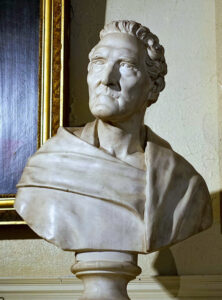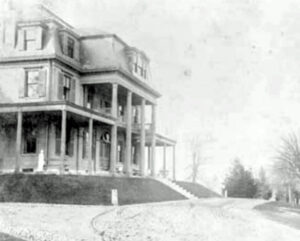True Tales from Canton’s Past: The Virtue of Giving
By George T. ComeauThere are old virtues that still ring true today. The value of integrity, economy and perseverance. Are these subjects that come up in the course of discussion in modern-day families? Many readers will look upon their lives and find that they are wealthy, and the question is whether they choose to use their wealth for “good works.” Do we find ways individually to “relieve the poor and distressed, to treat those less fortunate than themselves with kindness, remembering that, in a few short years, the grave will make all fortunes equal.” These words come from a memorial to a man from Canton. And there can be no better example of these virtues than in the memory of Benjamin Bussey. The years have obscured his name, but rest assured his virtues live on.
Each day this author walks into a building on Arch Street in Boston. The lobby is made up of the two historic brick facades of buildings facing each other. High above a glass laylight splashes sun onto the marble floor. The space between the two buildings is today entirely enclosed. But many years ago this was a small downtown street named Bussey Place. Recently, the building owners remodeled the lobby and they painted a large sign into the bricks as a way to recall the name Bussey.
The Bussey family settled here in the early 1700s. The first mention of the family is the marriage of William Bussey to Olive Jordan in 1728. William owned land on what is now Turnpike Street and built a house near Reservoir Pond. William had a son named Benjamin who purchased land and became a farmer. In turn Benjamin Jr. was born in 1757 to parents that were relatively well known. Benjamin’s mother was the daughter of Deacon Joseph Hartwell and his aunt was married to Roger Sherman. The father was a “master-mariner” and often absent at sea. The early foundation of education came under the watchful eye of his maternal grandfather. In time, however, Benjamin’s father returned from sea and bought 20 acres of land and the family prospered moderately.
By the time of the American Revolution, Benjamin was 18 years old. The patriot cause stirred deeply in both father and son. The elder Bussey served as a Minuteman in 1775 and by 1781 was a captain in the militia. In 1795, Benjamin Sr. signed the petition for the incorporation of Canton. Meanwhile, the son was given his independence from his father and immediately joined the revolution.
Enlisting as a private in the Stoughton Minutemen, the young Bussey was a distinguished soldier. At age 19 he was rewarded with the office of quartermaster. Joining the regiment of Colonel Benjamin Gill, Bussey was in the Battles of Saratoga and Bemus Heights. Perhaps the most illustrious moment in his military career was witnessing the surrender of General Burgoyne. It is not hard to imagine the spirit in this man as he witnessed Burgoyne surrender his entire army, numbering 5,800. This was the greatest victory the American forces had up to that point in the Revolutionary War, and it proved to be the turning point in the war, as France entered into an alliance with the American patriots.
While Bussey was away at war, his mother died and he was unable to say goodbye. “The cold form of the love one was borne by tender hands through the narrow doorway, a victim of that scourge of those days, the small-pox.” Bussey returned to that small house near Reservoir Pond. Bussey’s return was unremarkable given all that he had accomplished; instead he spent two years in what was described as “lost time.” In the army he had acquired the habits of “idleness and expense,” in which he indulged greatly. In 1778 he decided to start a business. Bussey’s father had lost most of the family money due to bad debts and gave him what money he had. A far better gift was the advice he shared with his son: always be diligent, to spend less than you earn, and to never deceive or disappoint anyone.” Bussey’s grandfather gave him $50 in silver, and Bussey took up the skills of a silversmith in a small shop in Ponkapoag. Working with a Hessian soldier, he spent a year learning the art and craft of creating beautiful and useful items.
In 1780, Bussey married a woman from Dedham named Judith Gay. There could have been no more perfect match. Together they would form a partnership built upon the principles of prudence and industry. Over the course of living in Dedham on East Street for 10 years, Bussey ran a successful shop and began to build a small fortune in trade. He would send large quantities of fur to England and then receive the proceeds in merchandise that would be sold in Dedham. Between 1778 and 1790, Bussey accumulated $25,000, or the equivalent of $700,000 in 2020 dollars. Bussey took the $25,000 he made to Boston in 1790 where he ran a shipping and trading company for 16 years at five different locations.
In 1798, he moved to 5 Summer Street and opened a shop on State Street in Boston and expanded his trade through the acquisition of several large vessels. England, France and Holland were favored ports of call for the ships that would bring amazing and fantastic goods to Boston. There were many wealthy patrons who worked with Bussey to enrich their lives and pockets.
In 1802 he repaired the house of his childhood in Canton. “The rooms were high studded, which was then the fashion; the stairs ran at angles, with landings, through an ample hall. The woodwork was ornamented, and sufficient room provided for a small family. The front door was protected by a wooden canopy with iron support, curiously wrought. Trees were planted; side fences came down from the corners of the house to the front fence; and here was laid out a front yard, the pride of the farmers’ wives, planted with bouncing Bet, London pride, peonies and old-fashioned roses. Then, good son that he was, he gave the house to his father and his father’s second wife that they may enjoy the remainder of their lives with no fear lest the wolf should come to the door.”
It was said that Bussey “lived a life of gilded misery.” What was meant by that statement was that Bussey, now worth a large fortune, never lived ostentatiously. By the time he retired from his estate in Boston at age 49, he purchased a beautiful piece of land in Roxbury. He was one of the wealthiest men in New England and now committed his life to raising Merino sheep on a 300-acre farm. On his estate, which featured wallpaper views of Paris and French furniture, Bussey practiced scientific farming. After the War of 1812, Bussey established woolen mills in Dedham and used state-of-the-art machines to transform the textile factories he owned. He was one of the first to install water-powered broad looms in America, enabling him to spin and weave the raw wool into finished fabric. It was said that the factories, dye houses, dwellings, and other buildings associated with the operation “of themselves [constituted] a little village.” The wool from his sheep in Roxbury was used to create beautiful yarns that were highly sought after.
As skilled as he was at trade, Bussey’s love and devotion was the land and the science of farming. In Roxbury he called his estate Woodland Hill. Bussey had inherited land from fellow patriot Eleazer Weld in 1800 and further enlarged his estate between 1806 and 1837 by acquiring and consolidating various farms that had been established as early as the 17th century. Aside from the land in Roxbury, Bussey also owned large plots of land in Dixmont, Augusta, Newburg, Frankfurt, and Bangor, Maine, as well as factories in Massachusetts, including the Norfolk Cotton Company (purchased in 1819) and the Dedham Worsted Company (purchased in 1824). Bussey spent his retired life as a philanthropist and a prominent member of Roxbury and Boston elite society. He entertained American dignitaries, such as the Revolutionary War hero Marquis de Lafayette, President Andrew Jackson, Vice President Martin Van Buren, and Governor William Eustis.
The greatest accomplishment of Benjamin Bussey was what he left behind with the intent that it would make lives better. Benjamin Bussey died in 1842, a few months shy of his 85th birthday.
Bussey’s will, drawn up in 1835, gave an endowment to Harvard University for the establishment of an undergraduate school of agriculture and horticulture to be called the Bussey Institution, as well as a grant of land from his estate in Roxbury. By 1871, new Bussey Institution buildings neared completion and students became enrolled in what would be one of the finest biological and agricultural institutions in America. James Drummond Dole obtained a bachelor’s degree in agriculture at the Bussey Institute before moving to Hawaii and developing pineapple growing and a canning industry there. Alfred Kinsey, an American biologist who became famous for his work on human sexuality, studied at the Bussey Institute under famed entomologist William Morton Wheeler. And at least one future landscape architect was enrolled in the program. He was Charles Eliot, son of Harvard President Charles Eliot, who was later employed by Frederick Law Olmsted.
The gift of the land to Harvard has had an impact to this day. Adjoining the Bussey property was that of James Arnold, a whaling merchant from New Bedford. When Arnold died he specified that a portion of his estate was to be used for the “promotion of agricultural, or horticultural improvements.” The income from Arnold’s legacy was to be used for establishing, developing and maintaining an arboretum to be known as the Arnold Arboretum, which “shall contain, as far as practicable, all the trees and shrubs … either indigenous or exotic, which can be raised in the open air of West Roxbury.” Arnold’s gift was combined with 120 acres of the Bussey Institute and today is known as the Arnold Arboretum. After Bussey’s death, a biographer wrote that the legacy of Benjamin Bussey is a testament to the fact that “good deeds, done to others, are the foundation of happiness and respect in this life.” Words for all of us to live by.
Short URL: https://www.thecantoncitizen.com/?p=72168












